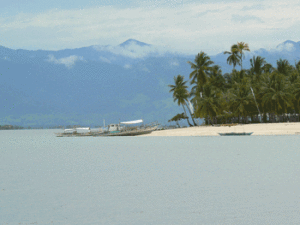
Honda Bay, Palawan, the Philippines
Part Two: Palawan
Text and photos © Scott W Clemens
I have to admit when I received an offer to visit Palawan I had to get out a map. Even when I found out where it was, I expected to find a bustling island with strong Asian influence (afterall, it lies across the South China Sea from Vietnam). What I found was something quite different and altogether unique.
Palawan (Pa-LA-wan) is a rarely visited corner of the Philippines, being neither a center of commerce, nor of manufacture. Palawan is the name of both the province, which encompasses 1,780 islands and islets, and the name of the biggest island. Palawan Island is long and mountainous — 430 miles long, only 20 miles at its widest, with jungle covered mountains reaching over 5,000 feet. Its 1,300 miles of coastline fronts the Sulu Sea on the east, the South China Sea on the west.
The island’s biggest industry is fishing, and in fact Palawan’s fishermen supply 60% of the fish eaten in Manila. Next in importance is agriculture, the biggest cash crops being mangos and cashew nuts. Tourism runs a distant third.
Visitors come to Palawan for nature and adventure.It contains two UNESCO World Heritage sites: Tubbataha Reef, a National Marine Park in the Sulu sea with over 300 corals species, sea turtles, Manta Rays and almost 400 species of fish; and Puerto Princesa Subterranean River National Park which, at 8 km, is the longest underground river accessible by man. There are a few resorts on the island, but development is sparse, particularly considering the length of the island (the same distance as San Francisco to Los Angeles). Cited by National Geographic Traveler as one of the most bio-diverse islands in the Philippines for both terrestrial and marine life, much of the island is untouched by humans. Last year only 10,000 tourists visited the island, about the same number that visit Oahu each week.
About 750,000 people live on the island, including nine primitive tribes. The Tau’t Bato (men of rock) live in caves, hunt with blow darts and practice voodoo. About 165,000 people live in the capital city of Puerto Princesa, a city with airline service to Manila 360 miles to the northwest.
I imagine that Puerto Princesa is similar to Honolulu in the 1920s. It has a distinct South Seas feel (replete with tikis), but as yet without the touristy shtick. We stayed at The Legend Hotel. It has a friendly staff, air-conditioned rooms, wireless internet in the lobby, and an excellent restaurant.
 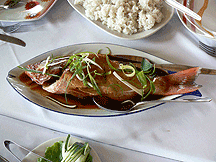
|
For a restaurant with a view, head for Badjao Seafront Restaurant, which is reached by walking out a long bridge through a mangrove forest. The open-sided restaurant is built on pilings over the water, and serves inexpensive, fresh food from local ingredients. We enjoyed molo, a pork won ton soup with roasted garlic and spring onion; deep-fried Chinese eggplant stuffed with ground beef; Lapu-Lapu, a local fish; spicy sweet shrimp; pork belly adobo, and spinach in oyster sauce. Be sure to give the taxi driver the full name — Badjao Seafront Restaurant, as there is another Badjao restaurant in town. Come early enough to watch the local fishermen plying the mouth of Puerto Princesa Harbor and sunset over the water.
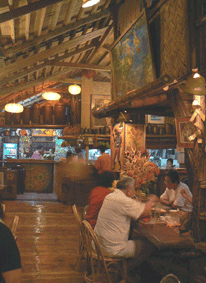
Ka Lui restaurant on Palawan
When searching for a good restaurant at reasonable prices, the universal rule of thumb is “go where the locals go.” In Puerto Princesa that would be Ka Lui (brother Lui), which has been jam-packed for 20 years. The building has a warm ambience, built of bamboo and carved wood, with the sides open to the air to let the breeze through. We had a seafood soup with a coconut-fish broth, mixed vegetables in coconut cream sauce, squid, Ahi tuna steak, and shrimp tempura. Shoes are left at the entrance, and diners have the choice of eating at a table, or Japanese-style on the floor.
Several half-day excursions are possible from Puerto Princesa, including a butterfly garden, a crocodile farm, and a penal colony. All of the tours can be arranged through the hotel, or through Rajah tours in Manila, which has affiliates on Palawan.
The butterfly garden is small in size, but contains hundreds of colorful butterflies, as well as exotic tropical flowers. It’s not that you won’t see butterflies in the wild (they’re everywhere in Palawan), but here they’re concentrated and confined for easy viewing.
A short drive out of town, the Crocodile Farming Institute is a joint project of the Filipino and Japanese governments to preserve an endangered species of Philippine crocodile. There you’ll see an amazing number of crocs of all sizes. Just a five-minute drive down the dirt road from the crocodile farm, you’ll arrive at Iwahig Penal Colony, a prison without walls. It’s a unique prison, encouraging inmates to learn rice farming and crafts.To be eligible for the program, the inmates must have been sentenced from between 4 and 20 years. A drive through the rice paddies brings you to the center of prison,where you can

Baby crocs at the Crocodile Farming Institute on Palawan
buy handicrafts made by the prisoners (everything from carved wood to jewelry). The prisoners feed themselves through farming, selling the excess, and make extra money through craft sales. The project has been so successful that 10% of the prisoners elect to stay on after their sentences are complete; they can then petition to have their families join them.
While in Puerto Princesa, you’ll want to make a full-day roundtrip to the Puerto Princesa Subterranean River National Park, a 20-minute boat ride from Sabang, on the South China Sea side of the island. To get to Sabang you have to drive 81 punishing kilometers. The first hour of the trip is a pleasant tour of the mountainous countryside, along narrow but well-kept roads. The second hour (to an hour and a half) is a kidney-punching adventure on a rough, unpaved road, nearly impassible in the rainy months. The government is working slowly at paving the road in sections, as funds become available, but I wouldn’t expect the dirt part of the road to be fully paved before 2010 or beyond.
Nonetheless, if you’re intrepid enough to make the trip, you’ll be rewarded with magnificent jungle scenery and views of a way of life that has changed little in a millennium — people livingwithout electricity or running water in huts of thatched bamboo, farming small plots of land with the help of trusty water buffalo. It gives you a different perspective to see that all of the accoutrements of modern civilization that we find so indispensable, are indeed dispensable on a more basic level.
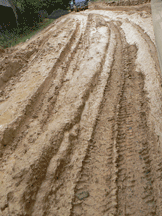
Some roads are so muddy that they’re nearly impassable without four-wheel drive.
In such a warm climate the locals don’t spend much time indoors; instead you’ll see people sitting in front of their woven houses, or on a rainy day sitting in a row under a thatched porch. Out here in the jungle many huts are beyond the reach of electricity. Without television, radio, the internet or video games, what do they do to occupy their time? I suspect they discuss the crops and weather and tell old stories that have been passed on from generation to generation. And yet, along the way you’ll see the modern world penetrating this ancient way of life: to market their produce these farmers travel to Puerto Princesa, the only big town on the island, hanging onto, or perched atop of the overloaded local Jeepney; I saw a man, clad only in shorts, squatting by the side of the muddy road talking on his cell phone (where did he charge it?); and at the half way point of our journey we stopped at a thatched bamboo hut that had tapped into the electrical grid to power a small television where children gathered to watch cartoons.
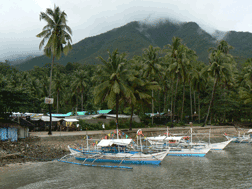
Catamarans at Sabang wait to take passengers around the point to St. Paul’s Underground River
Once again we relied on a guide to get us to Sabang. During the dry season I wouldn’t have hesitated to rent a car, but here in the rainy season the mud was deep and several times the tires sank so deep that the bottom of the van scraped along the road. I was amazed our driver could manage, and I wouldn’t have wanted to risk being stuck in the jungle with a rental car.
Sabang is a small settlement on a half-mile stretch of beach. Anchored next to the quay is a flotilla of colorful catamarans, suitable for ferrying six tourists on the 20-minute ride around the point to St. Paul’s Bay. Be forewarned that getting into and out of the catamaran you’re going to get wet (from ankle-deep to knee-deep), so wear shorts and sandals. Once around the point you’ll land on a beautiful white sand beach, and walk five minutes along a boardwalk through a forest of mangrove and coconut trees to the entrance of the underground river. You might want to linger on the boardwalk to spy on the local wildlife: Macac monkeys and Monitor lizards. After donning a hardhat and life vest, you’ll board a six-person catamaran for a 45-minute tour of St. Paul’s Underground River. You’ll enter the cave at the base of towering limestone cliffs. While the river has been measured at 8.2 kilometers, the tour only penetraes 1.5
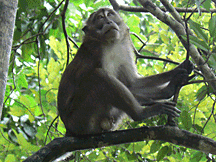 Macac monkey |
 Monitor Lizard Monitor Lizard |
kilometers into the inky blackness. Whoever sits in the bow is given a searchlight to point out the sites — stalactites, limestone columns sculpted by eons of dripping water, and cathedral-like caverns. Bats hang from the ceiling, water drips steadily all around you (and on you), and the cave is alive with echolocating swallows hunting insects.
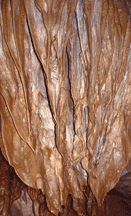
Limestone formations in St. Paul’s Underground River
The return trip to Sabang gives you another perspective on the town. Behind the beachfront coconut groves the dome of the church rises above the trees, and higher still (sing hallelujah) is the local cell phone tower. Spread out under the bamboo trees along the arcing beach, you’ll see several clusters of huts advertising overnight accommodations and restaurants: Mary’s, Tarwa Beach Resort, Green Verde and Robert’s. We ate at the latter, under a thatched roof on the beach, though our tour guide recommended Tarwa for overnight beachfront accommodations (the one thatched cabin I saw at Robert’s was Spartan, to say the least). A tenth of a mile up the road you’ll find more luxurious accommodations at Green Forest, fancied by bird watchers.
After a couple days in Puerto Princesa we transferred to Dos Palmas resort in Honda Bay, a 25-minute bus ride followed by a 50-minute boat ride from the city. Honda Bay, the next bay north of Puerto Princesa, is dotted with dozens of small islets, some of which disappear at high tide. A large river empties into the bay carrying silt from the mountains to the Sulu Sea. Silt forms sandbars that become exposed at low tide; mangrove seeds get a foothold in the sand, and as more and more silt is trapped in the roots of the mangroves, a new island is born.
One such island is Arreceffi, site of Dos Palmas resort and spa. Air-conditioned accommodations include 19 Beach Villas with 4 rooms each with a view of the mangroves, and 10 Bay Cottages set on pilings over the water. The daily charge of
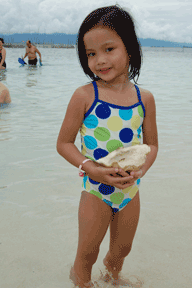 This little girl in Honda Bay, picked up half of a giant clam shell, in which swam a tiny reef fish. I was too wet to handle a camera, so asked my colleague, Roger Canfield, to take a photo. photo © 2007 Roger Canfield |
$238 USD per person includes all meals, boat transfers, ocean kayaks, snorkeling equipment, resort bikes, a scuba dive or massage, and speedboat transfers to snorkeling and picnic sites on nearby islands. Here we spent a relaxing day island hopping to various snorkeling sites, featuring colorful coral reefs, some 300 species of reef fish, and warm water. I saw trigger fish, angels, tangs, parrot fish, wrasses, lion fish, and sea snakes. I found exotic shells (be careful not to take living mollusks), sand dollars and starfish. After bringing a giant clam shell in to the beach to show my colleague, Roger Canfield, I threw the shell back into the shallow water. A little girl, no more than three-years-old, picked it up, and there in the water collected in the shell was a tiny fish.
I usually wear a t-shirt when snorkeling (it’s better than sun block), but since it was an overcast day I didn’t think it necessary — don’t make the same mistake; I was burned to a crisp.
Before leaving Palawan you should pay a visit to one of the many jewelry shops on the island. Palawan is known for its exquisite pearls (the largest pearl ever found was discovered here), and the price of a necklace on Palawan is only third of what you’d pay in Manila, or a tenth of what you’d pay in the U.S.
Our stay was unfortunately short, but long enough to highlight the island’s charms. I’d like to return for some serious scuba diving, and to explore the island’s other UNESCO World Heritage site, Tubbataha Reef National Marine Park.
Ka Lui Restaurant
369 Rizal Avenue Puerto Princesa City, Palawan (048)433-2580. Typical meals between $7 and $10 USD per person. Closed Sunday.
Badjao Seafront Restaurant
Abueg Sr. Road, Bgy. Bagong Sikat Puerto Princesa City, 5300 Palawan (048)433-9912 Great seafood with views facing the water. About $10 USD per person.
 A tiny reef fish in a giant clam. photo © 2007 Roger Canfield |
The Legend Palawan
Malvar Street, Puerto Princesa City, Palawan, Philippines 5300
Tel: 048-434-4270
Fax: 048-434-4276
Email: sales@legendpalawan.com.ph
www.legendhotels.com.ph
Dos Palmas Arreceffi Island Resort
Honda Bay, Puerto Princesa City, Palawan
Tel: 637-4226 or 637-4236
Fax: 637-4230
Email: info@dospalmas.com.ph
www.dospalmas.com.ph

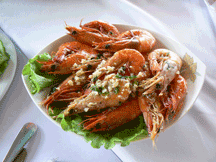
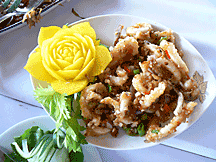 Dishes from Badjao Seafront Restaurant: clockwise — stuffed eggplant, Lapu-Lapu, squid, and shrimp.
Dishes from Badjao Seafront Restaurant: clockwise — stuffed eggplant, Lapu-Lapu, squid, and shrimp.